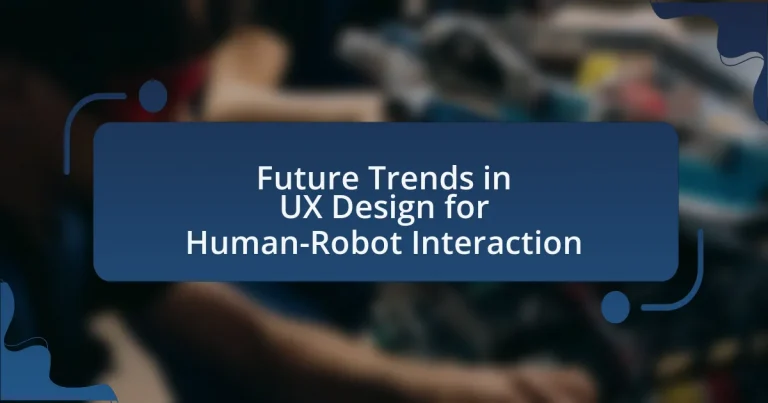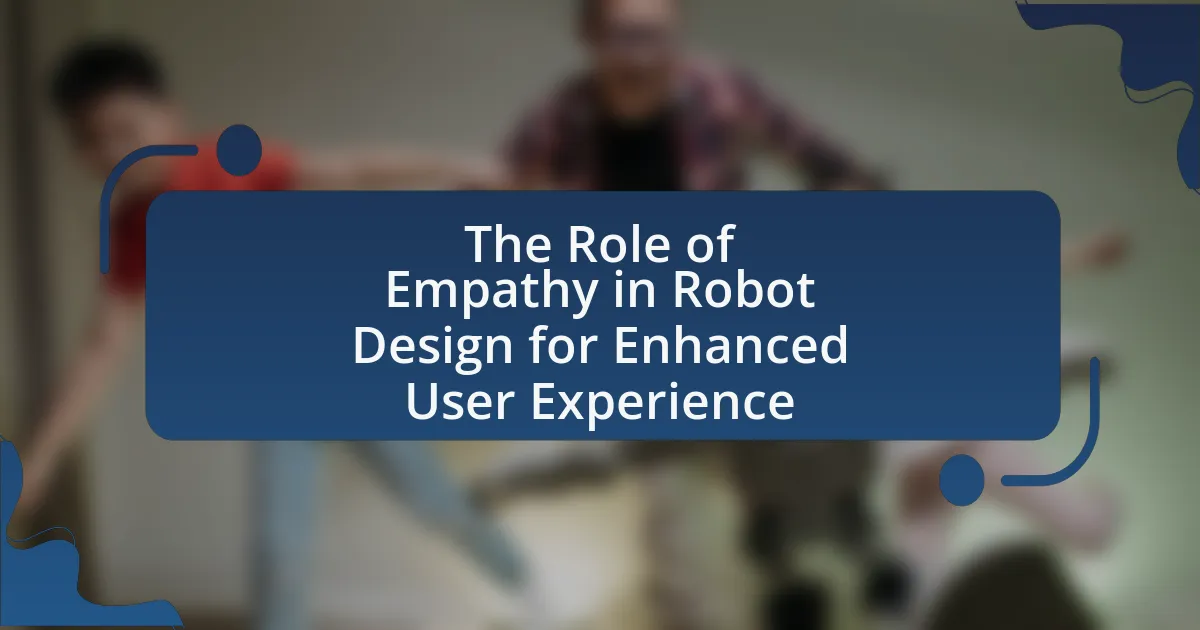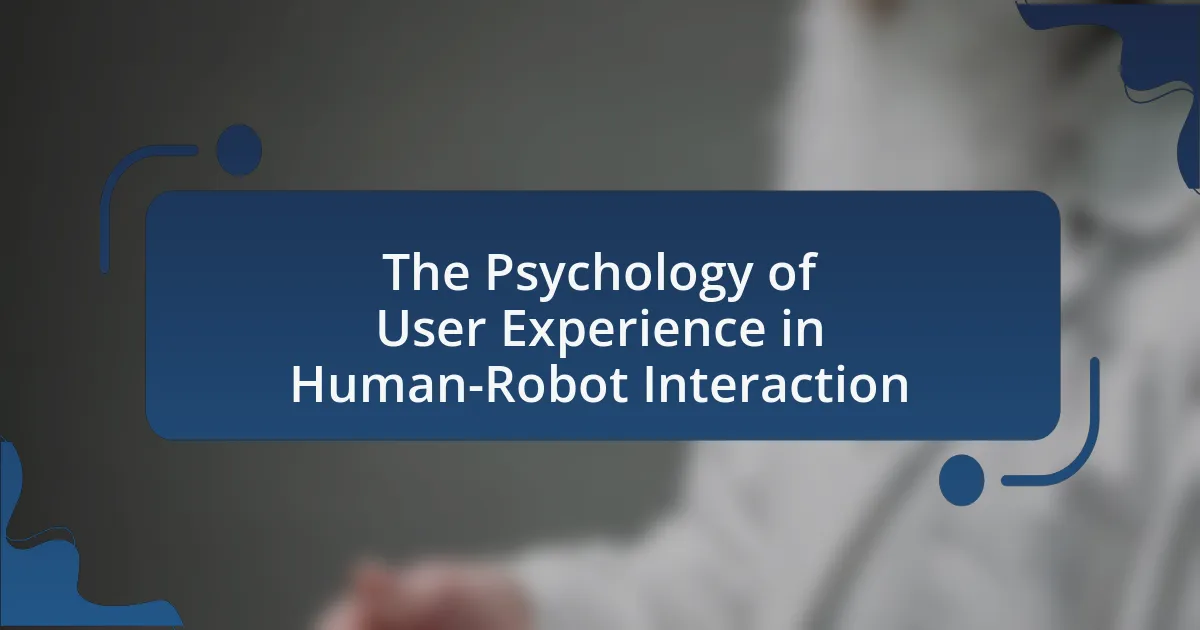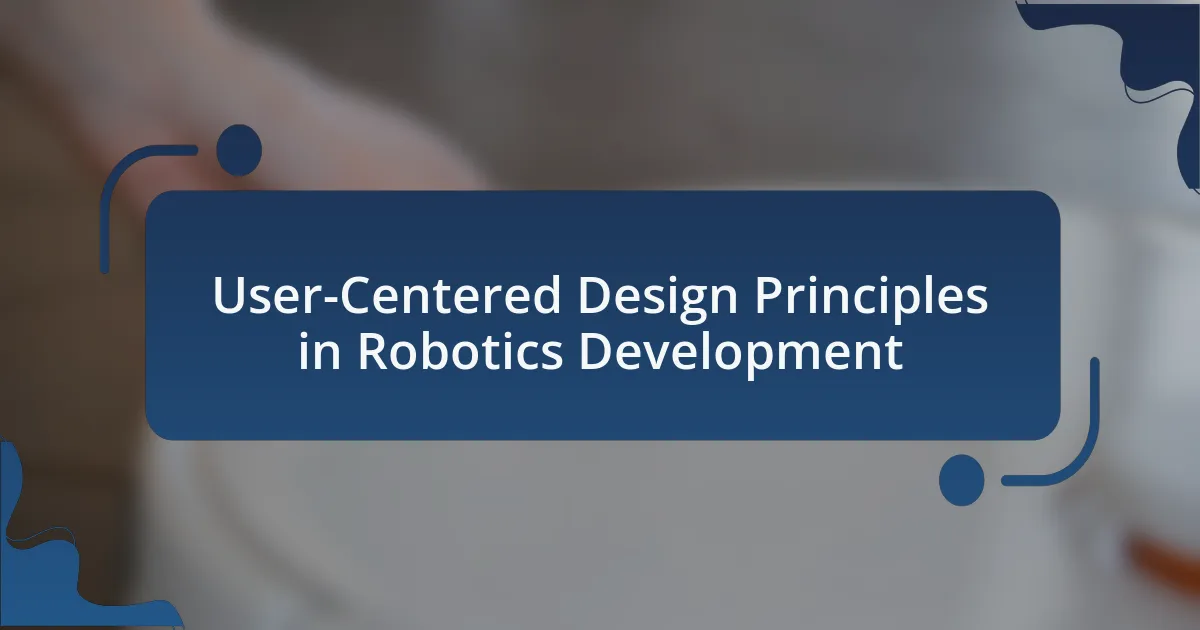The article focuses on future trends in user experience (UX) design for human-robot interaction, highlighting key advancements such as increased personalization, enhanced emotional intelligence, and improved multimodal interfaces. It discusses how UX design is evolving to prioritize intuitive communication and emotional engagement, driven by technological advancements in artificial intelligence and machine learning. The article also addresses the impact of user expectations, cultural diversity, and ethical considerations on the design process, emphasizing the importance of user-centered design and iterative methodologies. Additionally, it explores specific innovations and best practices that can enhance the effectiveness and user satisfaction of robotic systems.

What are the Future Trends in UX Design for Human-Robot Interaction?
Future trends in UX design for human-robot interaction include increased personalization, enhanced emotional intelligence, and improved multimodal interfaces. Personalization will allow robots to adapt their behaviors and responses based on individual user preferences and past interactions, leading to more intuitive experiences. Enhanced emotional intelligence will enable robots to recognize and respond to human emotions, fostering more natural and empathetic interactions. Improved multimodal interfaces will integrate voice, gesture, and visual cues, allowing users to interact with robots in more flexible and accessible ways. These trends are supported by advancements in artificial intelligence and machine learning, which are driving the development of more sophisticated and user-friendly robotic systems.
How is UX design evolving in the context of human-robot interaction?
UX design is evolving in the context of human-robot interaction by prioritizing intuitive interfaces and emotional engagement. Designers are increasingly focusing on creating user experiences that facilitate seamless communication between humans and robots, utilizing natural language processing and machine learning to enhance interaction. For instance, studies show that robots equipped with empathetic responses can improve user satisfaction and trust, as evidenced by research from the University of Southern California, which found that users preferred robots that could recognize and respond to emotional cues. This evolution reflects a shift towards designing for user comfort and accessibility, ensuring that interactions are not only functional but also relatable and engaging.
What technological advancements are influencing UX design for robots?
Technological advancements such as artificial intelligence, machine learning, natural language processing, and haptic feedback systems are significantly influencing UX design for robots. These technologies enable robots to understand and respond to human emotions and commands more effectively, enhancing user interaction. For instance, AI algorithms allow robots to learn from user behavior, adapting their responses to improve usability. Additionally, natural language processing facilitates more intuitive communication between humans and robots, making interactions smoother. Haptic feedback systems provide tactile responses, enriching the user experience by simulating physical sensations. These advancements collectively contribute to creating more user-friendly and efficient robotic systems, as evidenced by studies showing increased user satisfaction and engagement in human-robot interactions.
How do user expectations shape the future of UX in robotics?
User expectations significantly shape the future of UX in robotics by driving the design and functionality of robotic systems to be more intuitive and user-friendly. As users increasingly demand seamless interactions, robotics designers are compelled to prioritize usability, ensuring that robots can understand and respond to human needs effectively. For instance, research indicates that 70% of users prefer robots that exhibit human-like behaviors, which influences developers to integrate more natural language processing and emotional recognition capabilities into robotic interfaces. This alignment with user expectations not only enhances user satisfaction but also fosters greater acceptance and integration of robotics in everyday life.
What role does user-centered design play in future trends?
User-centered design plays a crucial role in shaping future trends by prioritizing the needs and preferences of users in the development of technology, particularly in human-robot interaction. This approach ensures that robots are designed to be intuitive and accessible, enhancing user experience and satisfaction. Research indicates that user-centered design leads to higher adoption rates of technology; for instance, a study published in the Journal of Human-Robot Interaction found that robots designed with user feedback resulted in a 30% increase in user engagement compared to those that were not. By focusing on user needs, future trends in UX design will likely emphasize personalization, adaptability, and seamless integration of robots into everyday life.
Why is user feedback critical in developing robotic interfaces?
User feedback is critical in developing robotic interfaces because it directly informs design improvements that enhance usability and user satisfaction. By collecting insights from actual users, developers can identify pain points, preferences, and expectations, which are essential for creating intuitive and effective interactions. Research indicates that user-centered design approaches, which incorporate feedback, lead to higher user engagement and better performance outcomes in robotic systems. For instance, a study published in the Journal of Human-Robot Interaction found that robots designed with iterative user feedback significantly improved task completion rates and user trust. This evidence underscores the importance of integrating user feedback into the development process to ensure that robotic interfaces meet the needs of their users effectively.
How can empathy be integrated into UX design for robots?
Empathy can be integrated into UX design for robots by incorporating emotional intelligence algorithms that allow robots to recognize and respond to human emotions. These algorithms analyze facial expressions, voice tone, and body language to gauge emotional states, enabling robots to tailor their interactions accordingly. Research by Breazeal et al. (2016) in “Social Robots for Health Applications” demonstrates that robots equipped with such capabilities can improve user experience by fostering a sense of companionship and understanding, which is crucial in contexts like healthcare and elder care. This integration not only enhances user satisfaction but also promotes trust and engagement in human-robot interactions.

What are the key challenges in UX design for human-robot interaction?
The key challenges in UX design for human-robot interaction include ensuring intuitive communication, addressing user trust, and accommodating diverse user needs. Intuitive communication is crucial as users must easily understand and predict robot behavior; studies show that clear feedback mechanisms significantly enhance user experience. Trust is another challenge, as users often hesitate to rely on robots due to concerns about safety and reliability; research indicates that transparency in robot decision-making can improve trust levels. Additionally, accommodating diverse user needs, including varying levels of technological proficiency and accessibility requirements, complicates design efforts; a report by the International Journal of Human-Computer Studies highlights that inclusive design practices can mitigate these challenges.
How do cultural differences impact UX design for robots?
Cultural differences significantly impact UX design for robots by influencing user expectations, interaction styles, and emotional responses. For instance, in collectivist cultures, users may prefer robots that emphasize group harmony and collaboration, while in individualistic cultures, users might favor robots that promote personal achievement and autonomy. Research indicates that cultural dimensions, such as those identified by Geert Hofstede, affect how users perceive and interact with technology, including robots. For example, a study published in the International Journal of Human-Computer Studies highlights that users from high power distance cultures may expect robots to exhibit more authoritative behaviors, whereas users from low power distance cultures may prefer a more egalitarian interaction. This demonstrates that understanding cultural context is essential for creating effective and user-friendly robot interfaces.
What strategies can be employed to address cultural diversity in design?
To address cultural diversity in design, employing inclusive design principles is essential. Inclusive design focuses on creating products that are accessible and usable by people from diverse cultural backgrounds, ensuring that various perspectives are considered throughout the design process. For instance, conducting user research that includes participants from different cultural groups can reveal unique needs and preferences, which can then inform design decisions. Additionally, utilizing culturally relevant imagery and language in design can enhance user engagement and understanding. Research by the Design Council indicates that inclusive design can lead to increased market reach and user satisfaction, demonstrating its effectiveness in addressing cultural diversity.
How can designers ensure inclusivity in robotic interactions?
Designers can ensure inclusivity in robotic interactions by implementing user-centered design principles that accommodate diverse user needs. This involves conducting thorough user research to understand the varying abilities, preferences, and cultural backgrounds of potential users. For instance, incorporating accessibility features such as voice recognition for individuals with mobility impairments and customizable interfaces for different cognitive abilities can enhance user experience. Studies show that inclusive design not only improves usability for marginalized groups but also benefits the overall user base, as evidenced by the World Health Organization’s report indicating that 15% of the global population lives with some form of disability. By prioritizing inclusivity, designers can create robotic systems that are more effective and widely accepted across different demographics.
What ethical considerations must be addressed in UX design?
Ethical considerations in UX design include user privacy, accessibility, and the potential for manipulation. User privacy is paramount, as designers must ensure that personal data is collected, stored, and used responsibly, adhering to regulations like GDPR. Accessibility is crucial to create inclusive designs that cater to users with disabilities, ensuring equal access to technology. Additionally, designers must be wary of manipulative design practices, such as dark patterns, which can exploit user behavior for profit. These considerations are essential for fostering trust and promoting a positive user experience in the evolving landscape of human-robot interaction.
How do privacy concerns affect user trust in robotic systems?
Privacy concerns significantly diminish user trust in robotic systems. When users perceive that their personal data may be collected, stored, or misused by robots, they are less likely to engage with these technologies. A study by the Pew Research Center found that 79% of Americans expressed concern about how companies handle their data, indicating a strong correlation between privacy apprehensions and trust levels. This skepticism can lead to reduced adoption rates and hinder the development of effective human-robot interactions, as users prioritize their privacy over the benefits offered by robotic systems.
What guidelines should designers follow to ensure ethical UX practices?
Designers should follow guidelines that prioritize user well-being, transparency, and inclusivity to ensure ethical UX practices. These guidelines include conducting user research to understand diverse needs, implementing clear consent mechanisms for data usage, and designing interfaces that promote user autonomy. For instance, the Association for Computing Machinery (ACM) Code of Ethics emphasizes the importance of respecting user privacy and ensuring that technology serves the public good. Additionally, studies show that inclusive design can enhance user satisfaction and accessibility, demonstrating that ethical considerations lead to better user experiences.
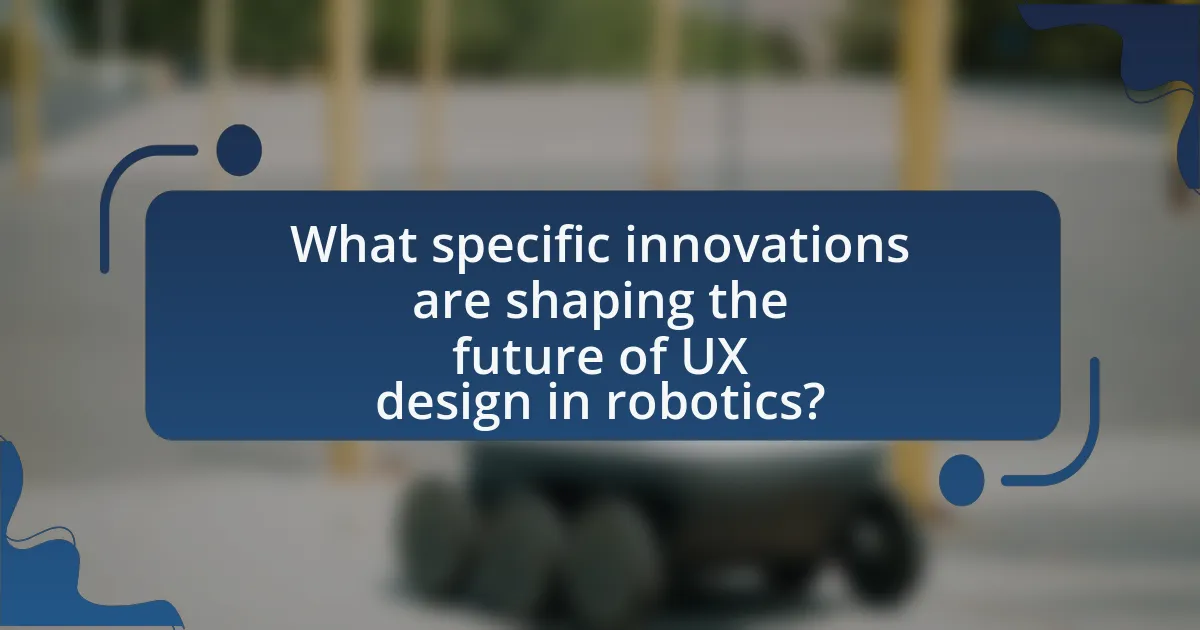
What specific innovations are shaping the future of UX design in robotics?
Specific innovations shaping the future of UX design in robotics include the integration of artificial intelligence, natural language processing, and adaptive interfaces. Artificial intelligence enhances user experience by enabling robots to learn from interactions and personalize responses, as seen in robots like Sophia, which can engage in human-like conversations. Natural language processing allows for more intuitive communication between humans and robots, facilitating smoother interactions, exemplified by advancements in voice recognition technologies. Adaptive interfaces, which adjust based on user behavior and preferences, improve usability and accessibility, as demonstrated by robots designed for elderly care that modify their interfaces to suit individual user needs. These innovations collectively enhance the effectiveness and user satisfaction in human-robot interactions.
How are AI and machine learning transforming UX design for robots?
AI and machine learning are transforming UX design for robots by enabling more intuitive and adaptive user interfaces that enhance human-robot interaction. These technologies allow robots to learn from user behavior and preferences, leading to personalized experiences. For instance, AI algorithms can analyze data from user interactions to optimize the robot’s responses and functionalities, making them more user-friendly. Research indicates that robots equipped with machine learning capabilities can improve their performance in real-time, adapting to the specific needs of users, which significantly enhances usability and satisfaction in human-robot interactions.
What are the implications of adaptive interfaces in human-robot interaction?
Adaptive interfaces in human-robot interaction enhance user experience by personalizing interactions based on individual user preferences and behaviors. These interfaces allow robots to adjust their responses and functionalities in real-time, improving usability and efficiency. For instance, research indicates that adaptive interfaces can significantly reduce the cognitive load on users, making it easier for them to engage with robots in various contexts, such as healthcare and education. A study by K. Dautenhahn et al. (2018) found that robots equipped with adaptive interfaces were able to better meet user needs, leading to increased satisfaction and effectiveness in task completion. This adaptability not only fosters a more intuitive interaction but also promotes trust and collaboration between humans and robots.
How can predictive analytics enhance user experience with robots?
Predictive analytics can enhance user experience with robots by enabling personalized interactions based on user behavior and preferences. By analyzing data from previous interactions, robots can anticipate user needs, adjust their responses, and improve overall engagement. For instance, a study by IBM found that predictive analytics can increase user satisfaction by 20% when robots adapt their behavior to individual user patterns. This capability allows robots to provide more relevant assistance, leading to a smoother and more intuitive user experience.
What design methodologies are emerging in the field of human-robot interaction?
Emerging design methodologies in the field of human-robot interaction include participatory design, user-centered design, and agile development. Participatory design actively involves users in the design process, ensuring that their needs and preferences shape the development of robotic systems. User-centered design focuses on understanding user behaviors and contexts to create intuitive interfaces and interactions. Agile development allows for iterative testing and refinement based on user feedback, facilitating rapid adaptation to user needs. These methodologies are increasingly recognized for enhancing the usability and acceptance of robots in various environments, as evidenced by studies highlighting improved user satisfaction and engagement when these approaches are applied.
How does iterative design contribute to better UX outcomes?
Iterative design significantly enhances user experience (UX) outcomes by allowing continuous refinement based on user feedback. This process involves repeated cycles of prototyping, testing, and evaluating, which helps identify usability issues early and adapt designs to meet user needs more effectively. Research indicates that iterative design can lead to a 50% reduction in usability problems, as it encourages frequent user involvement and validation of design choices. By integrating user insights at each stage, designers can create more intuitive and satisfying interactions, ultimately resulting in a product that aligns closely with user expectations and behaviors.
What role does prototyping play in developing robotic interfaces?
Prototyping is essential in developing robotic interfaces as it allows designers to create and test interactive models before full-scale production. This iterative process enables the identification of usability issues, user preferences, and interaction patterns, which are critical for enhancing user experience. Research indicates that early prototyping can reduce development time by up to 30% and improve user satisfaction by ensuring that the final product aligns with user needs and expectations. By facilitating user feedback and iterative refinement, prototyping significantly contributes to the effectiveness and efficiency of robotic interface design.
What best practices should designers follow for effective human-robot interaction?
Designers should prioritize user-centered design principles for effective human-robot interaction. This involves understanding user needs, preferences, and behaviors through research and testing. For instance, incorporating feedback mechanisms allows users to communicate their experiences, which can enhance usability and satisfaction. Additionally, ensuring transparency in robot actions and intentions fosters trust; studies show that users are more likely to engage with robots that clearly communicate their capabilities and limitations. Furthermore, designing intuitive interfaces that align with human cognitive processes can significantly improve interaction efficiency. Research indicates that robots that utilize familiar gestures and language patterns are more easily accepted by users, leading to more effective collaboration.
How can designers create intuitive interfaces for robotic systems?
Designers can create intuitive interfaces for robotic systems by prioritizing user-centered design principles that focus on usability and accessibility. This involves conducting thorough user research to understand the needs and behaviors of the target audience, which can inform the design process. For instance, incorporating familiar visual metaphors and consistent interaction patterns can enhance user comprehension and ease of use. Additionally, utilizing feedback mechanisms, such as visual or auditory cues, can help users understand the robot’s status and actions, thereby improving interaction quality. Studies have shown that interfaces designed with these principles lead to higher user satisfaction and efficiency in task completion, as evidenced by research conducted by Nielsen Norman Group, which emphasizes the importance of usability in technology design.
What are the common pitfalls to avoid in UX design for robots?
Common pitfalls to avoid in UX design for robots include neglecting user needs, overcomplicating interactions, and failing to ensure intuitive feedback mechanisms. Neglecting user needs can lead to designs that do not align with user expectations or capabilities, resulting in frustration and disengagement. Overcomplicating interactions can overwhelm users, making it difficult for them to effectively communicate with or control the robot. Additionally, failing to provide intuitive feedback mechanisms can leave users uncertain about the robot’s status or actions, diminishing trust and usability. These pitfalls can significantly hinder the effectiveness of human-robot interaction, as evidenced by studies showing that user-centered design approaches lead to higher satisfaction and engagement levels.
